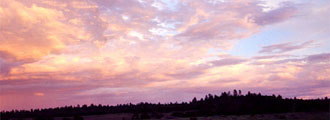| Dry
Fork Canyon contains some of the best known examples of Barrier
Style rock art and Classic Vernal Style rock art. The site
contains both petroglyphs and pictographs, estimated to date
back to 1-1200 A.D. The rock art is believed to be affiliated
with the Fremont Culture.
Barrier
Style rock art tends to be large. Most of the figures are
4 to 9 feet in height. This style usually extends from Northeastern
Arizona, through Utah and into Southwestern Wyoming. Eastern
Utah in particular contains a number of such sites. The Classic
Vernal rock art tends to be characterized by elaborately decorated
figures. Some of the images are colorfully painted, while
only traces of pigments remain on other petroglyphs.
Visitors will find that the petroglyphs and pictographs of
this particular site line the canyon for two to three miles.
The parking lot is situated approximately halfway between
the north and south sets of images. The most famous of these pictographs
is the Three Kings Panel, which was featured in National
Geographic. It is perched on a cliff face at the south
end of the site. The figures here are roughly seven to nine
feet in height.
Pithouses
and several other artifacts have been found at this site,
though they are not the main attraction.
The site is listed in 1975 on the National Register of Historic
Places for Utah.
Please respect the site and do not touch the rock art, since
the oil and chemicals from your fingerprints will severely
deteriorate the artwork over time. Also, be aware that the
sites are on private property, so please stay on the paths
and respect the rights of the property owners. Make sure you
check in and pay the entrance fee at the site, so the site
will continue to remain open to the public.
Location: Northeastern Utah, near Vernal.
|

